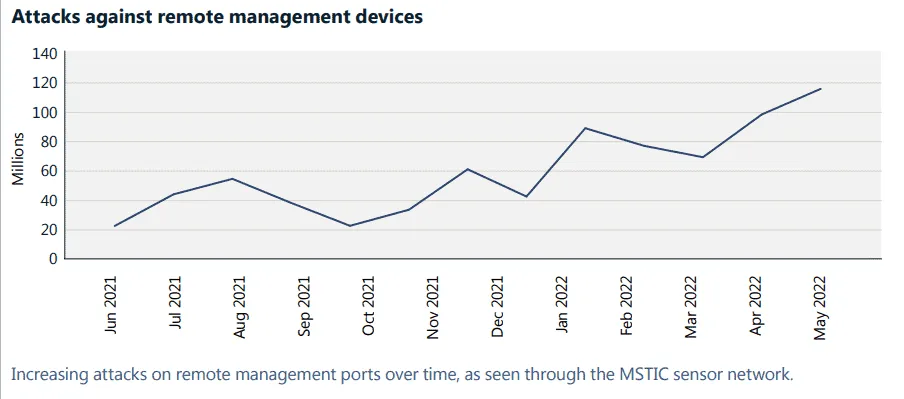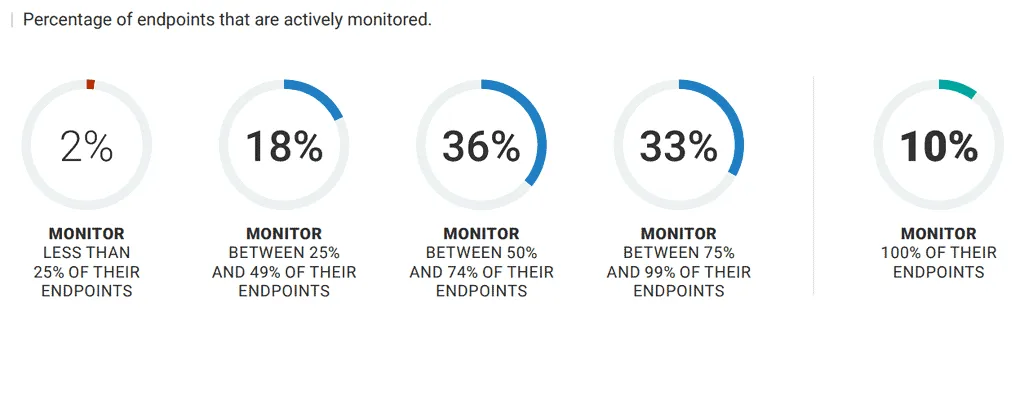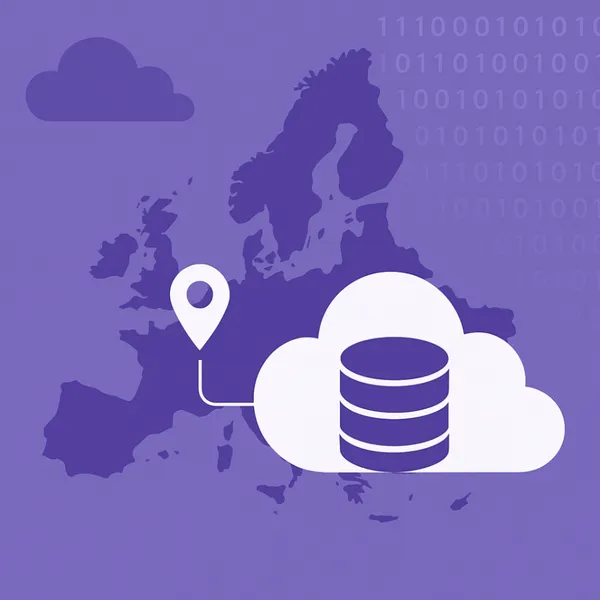
Knowledge base
April 09, 2023
Optimize your endpoint and device management with Microsoft Intune
As the digital world continues to expand and evolve, so does the need for robust cybersecurity solutions. In today’s connected landscape, organizations must protect their networks from a variety of threats by using effective endpoint security and management practices. Microsoft Intune is an essential suite of utilities that can help increase IT efficiency while providing greater protection against cyber attacks on Internet of Things (IoT) devices and operational technology (OT).
This article discusses insights into the Endpoint Vulnerability Gap in Mid-Market &Enterprise Organizations (North America) and how Microsoft InTune can help you with your endpoint management needs. We will also explore the Microsoft 365 E3 Do More with Less (DMWL) promotional offer, which provides an easy way for businesses to get started with these robust cybersecurity solutions.
Revealing cybersecurity trends for the Internet of Things (IoT) and operational technology (OT)
The Internet of Things (IoT) and Operational Technology (OT) are two emerging technologies that have the potential to revolutionize the way businesses around the world operate.
The Internet of Things (IoT) represents a network of interconnected devices that can collect and share data, enabling more efficient processes such as predictive maintenance and asset management for facility management operations. It can also provide insight into customer behavior that can be used to better target marketing efforts or identify new revenue streams. Operational technology (OT) is a combination of hardware, software and digital connectivity designed to help organizations automate operations and improve productivity. This includes applications such as robotics, process digitization, automated inspections and more.
Using both IoT and OT can offer organizations numerous benefits, including improved operational efficiency, reduced costs, enhanced security protocols and better customer service capabilities. Moreover, it can help companies prepare for disruptions in the market by giving them real-time insight into their operations, leading to faster decision-making processes.
While businesses have much to gain from investing in IoT and OT technologies, their rapid adoption in many local, national and international organizations now presents a significant opportunity for cybercriminals or threat actors to digitally attack any business with weak (or non-existent) cybersecurity defenses.
IoT devices, including surveillance systems, HVAC devices and building access controls, can pose exceptional cybersecurity risks to networks, individuals and organizations. The rapid deployment of IoT solutions in many industries worldwide has led to an increase in the risk of exposure to organizations and the number of potential attack vectors. The risk exposure does not lie solely with the organization in question. If one of their remote suppliers is compromised through a cyberattack, it could give hackers access to the networks to which those suppliers are connected.
Below is a summary of the main types of cyber attacks on IoT/OT.

Source: Microsoft Digital Defense Report 2022
As can be seen in the chart above, the top 3 attacks are on IoT / OT remote management (46%), web (30%) and databases (18%). IoT devices pose unique security risks as access points and pivot points in an organization’s network. Despite this threat, millions of IoT devices are exposed or do not have a security patch program.
Threat actors can use such exposure to devastating effects, as evidenced by the steady increase in cyber attacks on remote management devices between 2021 and 2022 (see chart below).

Source: Microsoft Digital Defense Report 2022
Open network ports are generally used for remote management of devices.
According to Microsoft’s cybersecurity research last year, cybercriminals can discover vulnerable organizational devices through online tools that detect services “listening” on open network ports. The ability to “listen” on an open network port can help a hacker gauge whether the connected device can be used as a “pivot” to infiltrate yet another layer of an organization’s network (especially if there is no cyber threat detection system in place).
What can be done to protect the IoT/OT in your organization?
Here are a few suggestions from Microsoft’s security team: Make sure certain industrial control system (ICS) protocols are not directly exposed to the Internet.
Ensure devices are robust by applying patches, default passwords and default SSH (Secure Shell) ports.
Use an IoT/OT-aware network detection and response (NDR) solution and a Security Information and Event Management (SIEM)/SOAR (Security Orchestration and Response) solution to monitor devices for anomalous or unauthorized behavior, such as communication with unknown hosts.
Increase IT efficiency and cybersecurity with the Microsoft Intune suite
Understanding the endpoint vulnerability gap in mid-market & enterprise organizations (North America)
In 2022, TechTarget’s Enterprise Strategy Group (ESG) surveyed 381 IT and cybersecurity decision makers in North America involved in security technologies and endpoint management at midsize (100 – 999 employees) and enterprise (1,000+ employees) organizations.
The results highlighted a significant discrepancy in how organizations address their endpoint security issues as part of their broader cybersecurity strategy. According to their findings, “80% of organizations actively monitor at least half of their devices, only 10% do so for all of their endpoints” (see infographic below).

Source: Enterprise Strategy Group by TechTarget
That lack of vigilance (only 10% of survey respondents monitored all of their endpoints) highlights a critical gap in the cybersecurity posture of several companies, especially those that view device management as the same level of cybersecurity as endpoint monitoring. Therefore, it is no surprise that of the organizations surveyed, more than 70% experienced cyber attacks caused by an unknown, unmanaged or poorly managed endpoint. Of that number, 34% experienced several cyber attacks, while 43% experienced only one cyber attack.
The final insight to be highlighted from this study is that “those organizations that cross the 20% threshold in terms of unmanaged devices are nearly 11x more likely than those with less than 5% unmanaged devices to have experienced multiple endpoint-centric cyber attacks.”
How can your organization address the Endpoint Vulnerability Gap by 2023? Read below for more information.
How can Microsoft InTune help with your Endpoint Management?
Microsoft Intune is a leading unified endpoint management solution that companies use to ensure that their operating systems, devices and business applications are secured and updated (especially when dealing with the evolving landscape of cyber threats and ransomware).
This unique solution can help your organization to:
1. Strengthen cybersecurity. Mitigate device threats, protect corporate data and improve compliance with advanced security features.
2. Reduce IT costs. Do more with less by consolidating your endpoint management and security vendors and optimizing performance across devices.
3. Unify your endpoint management. Simplify IT and security workloads by combining your endpoint and security management tools.
According to recent data from Microsoft, 57% of organizations do not have visibility or control over a quarter of their endpoints or more. With a comprehensive endpoint security solution such as Microsoft InTune, you can benefit from the full picture of your endpoint management, providing superior insight into potential threats and vulnerabilities. With unified data sources in one data set, there are fewer blind spots, which means more actionable insights for your organization’s improved cybersecurity.
“The Microsoft Intune Suite is going to help us
consolidate our endpoint management solutions, cut costs, make our lives easier and keep hospital data secure
. I would highly recommend the Microsoft Intune Suite to any organization looking to improve their security posture.” – Ibrar Mahmood (IT Cyber Security Manager – Milton Keynes University Hospital NHS Foundation Trust)
Microsoft InTune can help you simplify your cybersecurity and reduce “mental overhead” (due to work aligning multiple cybersecurity monitoring platforms). This is done by creating a unified management console with all required workflows instead of using different management consoles to monitor different parts of your IT environment.
Want to learn more about this solution and how to secure your hybrid workforce, reduce IT management and complexity, and lower IT costs? Register for our webinar Cloud Management for Hybrid Work today!
Microsoft 365 E3 Do More with Less (DMWL) promotional offer
Microsoft is pleased to announce a new promotional offer for Microsoft 365 E3 as part of its DMWL (Do More with Less) campaign.
The Microsoft 365 E3 solution combines critical quality applications to increase work productivity and collaboration while securing your organizational data with intelligent security. Below is a list of some of the business applications available with this solution.

For a limited time, customers new to Microsoft 365 E3 can enjoy an exclusive 15% discount off the net partner price! This is for customers who have not previously purchased Microsoft 365 E3 on any platform (legacy or new commerce) or channel (direct, CSP or Enterprise Agreement). Customers are subject to the initial purchase restriction.
This offer is valid from Feb. 1, 2023 to June 30, 2023. On the renewal date of the annual subscription, standard prices apply.
For organizations that choose to commit to an annual subscription to Microsoft 365 E3, promotional pricing applies throughout the subscription period, yet another exciting reason to switch to Microsoft 365 E3.
Source: proserveit
Want to know more?

Related
blogs
Tech Updates: Microsoft 365, Azure, Cybersecurity & AI – Weekly in Your Mailbox.








